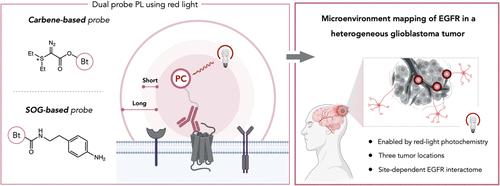胶质母细胞瘤中EGFR相互作用组的红光多探针光邻近标记
IF 15.6
1区 化学
Q1 CHEMISTRY, MULTIDISCIPLINARY
引用次数: 0
摘要
光催化接近标记已成为研究细胞背景下生物分子之间相互作用的一种有价值的技术,为蛋白质标记提供精确的时空控制。这些方法的一个显著优势是它们的模块化,允许使用单个光催化剂和不同的反应探针来扩大相互作用组的覆盖范围并捕获不同的蛋白质相互作用。尽管取得了这些进展,但使用红光激发的方法较少,限制了在更复杂的介质(如组织和动物模型)中使用光邻近标记。本文中,我们利用单一催化剂和两种不同的探针类型,开发了一个红光激发下的接近标记平台。我们首先设计了一个基于碳的标记系统,利用重氮磺胺探针。该系统成功应用于A549细胞,使用西妥昔单抗-氯e6偶联物捕获表皮生长因子受体(EGFR)的相互作用组。对已建立的技术进行基准测试表明,这种方法与领先的基于碳烯的接近标记方法相当。接下来,我们利用Chlorin e6强大的单线态产氧(SOG)能力,建立了苯胺和肼探针的替代标记系统。EGFR定向的化学蛋白质组学实验揭示了与carbene系统的显著重叠,carbene方法捕获了SOG系统识别的一个相互作用子集。最后,我们利用我们的方法在切除的人类胶质母细胞瘤(GBM)组织样本中表征EGFR,这些样本来自同一肿瘤的不同位置,代表肿瘤的浸润边缘和可行中心,确定了几种GBM特异性相互作用蛋白,这些蛋白可能作为未来治疗活动的起点。本文章由计算机程序翻译,如有差异,请以英文原文为准。

Multiprobe Photoproximity Labeling of the EGFR Interactome in Glioblastoma Using Red-Light
Photocatalytic proximity labeling has emerged as a valuable technique for studying interactions between biomolecules in a cellular context, providing precise spatiotemporal control over protein labeling. One significant advantage of these methods is their modularity, allowing the use of a single photocatalyst with different reactive probes to expand interactome coverage and capture diverse protein interactions. Despite these advances, fewer methods have been developed using red-light excitation, limiting the use of photoproximity labeling in more complex media such as tissues and animal models. Herein, we develop a platform for proximity labeling under red-light excitation, utilizing a single catalyst and two distinct probe types. We first design a carbene based labeling system that utilizes sulfonium diazo probes. This system is successfully applied on A549 cells to capture the interactome of epidermal growth factor receptor (EGFR) using a Cetuximab-Chlorin e6 conjugate. Benchmarking against established techniques indicates that this approach performs comparably to leading carbene-based proximity labeling methods. Next, we leverage the strong singlet oxygen generation (SOG) ability of Chlorin e6 to establish an alternative labeling system using aniline and hydrazide probes. EGFR directed chemoproteomics experiments reveal significant overlap with the carbene system, with the carbene approach capturing a subset of interactions identified by the SOG system. Finally, we deploy our approach for the characterization of EGFR in resected human glioblastoma (GBM) tissue samples removed from distinct locations in the same tumor, representing the tumor’s infiltrating edge and its viable center, identifying several GBM specific interacting proteins that may serve as a launch point for future therapeutic campaigns.
求助全文
通过发布文献求助,成功后即可免费获取论文全文。
去求助
来源期刊
CiteScore
24.40
自引率
6.00%
发文量
2398
审稿时长
1.6 months
期刊介绍:
The flagship journal of the American Chemical Society, known as the Journal of the American Chemical Society (JACS), has been a prestigious publication since its establishment in 1879. It holds a preeminent position in the field of chemistry and related interdisciplinary sciences. JACS is committed to disseminating cutting-edge research papers, covering a wide range of topics, and encompasses approximately 19,000 pages of Articles, Communications, and Perspectives annually. With a weekly publication frequency, JACS plays a vital role in advancing the field of chemistry by providing essential research.

 求助内容:
求助内容: 应助结果提醒方式:
应助结果提醒方式:


